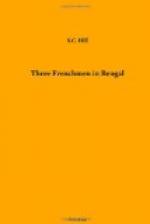We shall now pass to what went on in Siraj-ud-daula’s Court and capital.
FOOTNOTES:
[Footnote 12: Journal of M. d’Albert.]
[Footnote 13: Evidently the Parish Church of St. Louis. Eyre Coote tells us the French had four guns mounted on its roof.]
[Footnote 14: In early accounts of India the Muhammadans are always called Moors; the Hindus, Gentoos or Gentiles. The Topasses were Portuguese half-castes, generally employed, even by native princes, as gunners.]
[Footnote 15: Captain Broome says there were fifty European ladies in the Fort. The French accounts say they all retired, previous to the siege, to Chinsurah and Serampore.]
[Footnote 16: Captain, afterwards Sir, Eyre Coote.]
[Footnote 17: The fullest account is one by Renault, dated October 26, 1758.]
[Footnote 18: The only one, excepting the battle of Biderra, between the English and Dutch.]
[Footnote 19: Governor of Pondicherry and President of the Superior Council.]
[Footnote 20: Eyre Coote, in his “Journal,” mentions an old ditch, which surrounded the settlement.]
[Footnote 21: One hundred toises, or 600 feet; but Eyre Coote says 330 yards, the difference probably due to the measurement excluding or including the outworks.]
[Footnote 22: Tanks, or artificial ponds, in Bengal are often of great size. I have seen some a quarter of a mile long.]
[Footnote 23: Letter to M. de Montorcin, Chandernagore, August 1 1756. Signature lost.]
[Footnote 24: The Nawab, in July, 1756, extorted three lakhs from the French and even more from the Dutch.]
[Footnote 25: British Museum. Additional MS. 20,914.]
[Footnote 26: A kind of fibre used in making bags and other coarse materials.]
[Footnote 27: Surgeon Ives’s Journal.]
[Footnote 28: Letter to De Montorcin.]
[Footnote 29: Both English and French use this word “inhabitant” to signify any resident who was not official, military, or in the seafaring way.]
[Footnote 30: This he did through the Armenian Coja Wajid, a wealthy merchant of Hugli, who advised the Nawab on European affairs. Letter from Coja Wajid to Clive, January 17, 1757.]
[Footnote 31: A French doctor, who has left an account of the Revolutions in Bengal, says there were eight outposts, and that the loss of one would have involved the loss of all the others, as they could be immediately cut off from the Fort, from which they were too distant to be easily reinforced. The doctor does not sign his name, but he was probably one of the six I mentioned above. Their names were Haillet (doctor), La Haye (surgeon-major), Du Cap (second), Du Pre (third), Droguet (fourth), and St. Didier (assistant).]
[Footnote 32: M. Vernet, the Dutch Chief at Cossimbazar, wrote to the Dutch Director at Chinsurah that he could obtain a copy of this treaty from the Nawab’s secretaries, if he wished for it.]




